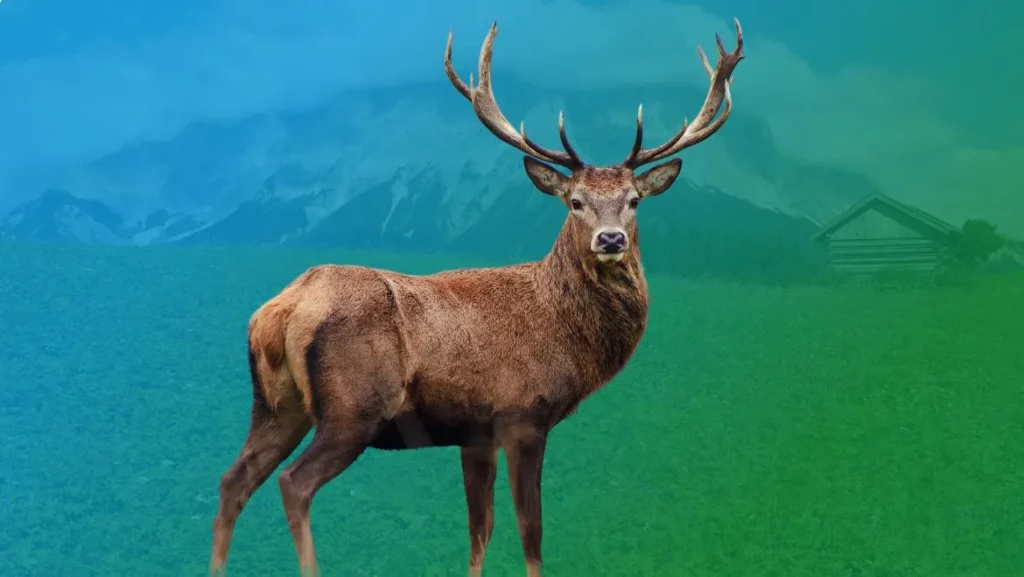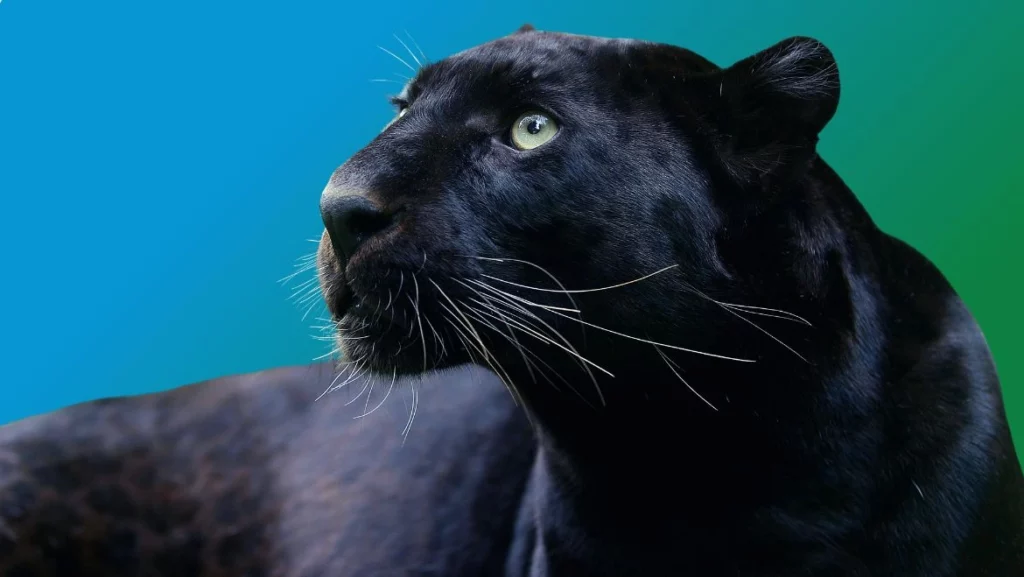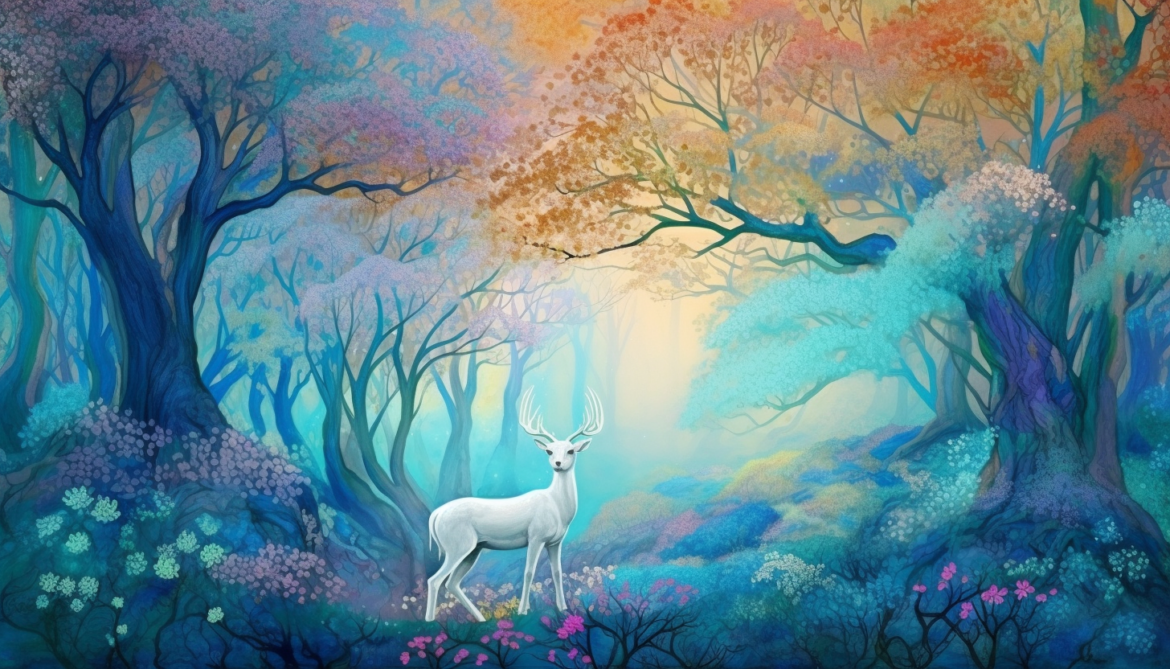Shamanism, an ancient spiritual practice rooted in the belief of a deeply interconnected world, transcends the boundaries of time and geography, touching the heart of numerous cultures across the globe. At its core, shamanism is founded on the principle that everything in the universe is imbued with spirit and life, from the towering trees and flowing rivers to the whispering winds and the solid earth beneath our feet. Shamans, the practitioners of this sacred tradition, navigate this spiritual landscape, acting as intermediaries between the human and spirit worlds. They embark on soulful journeys into other realms to gain wisdom, seek healing, and communicate with spiritual entities, guided by the rhythmic beat of the drum, the sacred chant, and the power of their intention.
Shamanic practices, though diverse in their expressions, share common threads such as the use of altered states of consciousness to engage with the spiritual realm, the belief in spirit guides or helpers, and the pursuit of healing and balance for individuals and communities. Shamans, whether adorned in the feathers and furs of the Amazon, the intricate costumes of Siberia, or the simple garb of a modern urban practitioner, serve as healers, advisors, and custodians of their community’s spiritual well-being.
The global presence of shamanism is a testament to its enduring relevance and adaptability. From the vast Siberian tundra to the dense rainforests of the Amazon, from the high peaks of the Andes to the rugged landscapes of Northern Europe, shamanic traditions have flourished, each shaped by the unique environment and culture from which they spring. Despite the passage of time and the pressures of modernity, these practices continue to thrive, offering insights into the human condition, our relationship with nature, and the unseen forces that animate the world around us.
This article aims to explore and compare various shamanic traditions, shedding light on their unique practices, cosmologies, and the role of the shaman within different cultural contexts. By journeying through the rich tapestry of global shamanism, we seek to understand not only the diversity of these spiritual paths but also the commonalities that unite them, revealing the universal human quest for connection, healing, and a deeper understanding of the mysteries of existence.
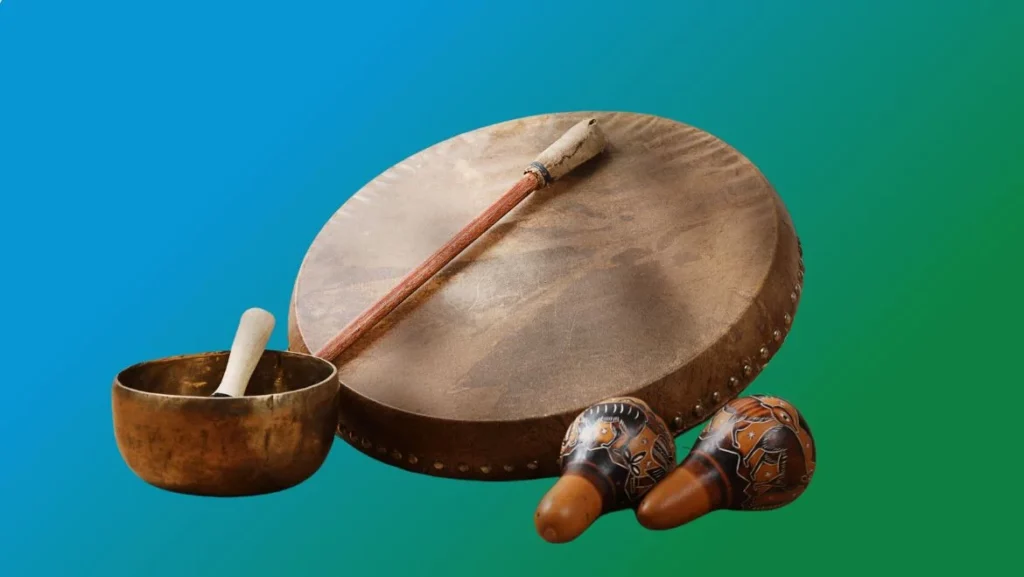
Historical Context and Origins
The origins of shamanism are as ancient and diverse as humanity itself, with roots stretching back to the Paleolithic era. Shamanic practices likely arose independently across different regions as early peoples sought to understand and influence the world around them through spiritual means. These early practitioners discovered that altered states of consciousness, achieved through various techniques such as drumming, dancing, fasting, or the use of psychoactive plants, allowed them to journey into other realms. In these spiritual landscapes, they encountered spirits, ancestors, and other entities, gaining knowledge, power, and healing abilities that they could bring back to their communities.
Early Evidence and Common Origins
Archaeological evidence, such as cave paintings in Europe, rock art in Africa, and shamanic artifacts from Siberia, provides glimpses into the shamanic practices of prehistoric peoples. These ancient artworks often depict shamanic journeys, spirit animals, and trance states, suggesting a widespread engagement with the spirit world.
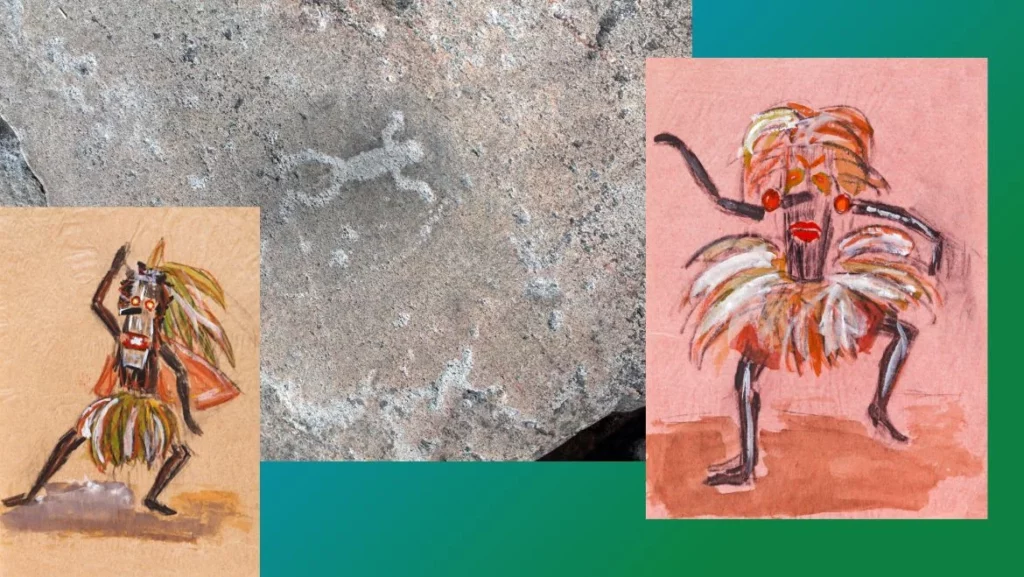
Shamanism in Indigenous Cultures
In indigenous cultures around the world, shamanism has been an integral part of the fabric of life, guiding communities through the challenges of existence. Shamans, often selected through spiritual callings or lineage, served multiple roles as healers, storytellers, ritual leaders, and mediators between the human and spirit worlds. Their deep understanding of nature, combined with their spiritual practices, allowed them to heal illnesses, predict events, and ensure the well-being of their communities.
Global Spread and Divergence
As human societies evolved and spread across the globe, shamanic practices diversified, adapting to the local cultures, environments, and spiritual beliefs. This led to a rich mosaic of shamanic traditions, each with its own distinct practices, tools, and cosmologies. For example, the shamanic traditions of the Amazon utilize the potent brew ayahuasca as a sacrament to induce visions and healing, while the shamans of Siberia are known for their drumming and elaborate rituals to journey into the spirit world.
Shamanism and World Religions
With the rise of organized religions, shamanic practices were often suppressed, marginalized, or assimilated. However, in many regions, these ancient practices persisted, either in pure form or syncretized with dominant religious traditions. Today, there is a resurgence of interest in shamanism, both within indigenous cultures seeking to preserve their heritage and among people around the world drawn to its direct, experiential approach to spirituality.
Amazonian Shamanism
The lush, biodiverse Amazon rainforest is home to a rich tapestry of indigenous cultures, each with its own unique shamanic traditions. Amazonian shamanism is deeply intertwined with the natural world, reflecting a profound relationship with the forest, its plants, and its spirits. Central to many of these traditions is the use of ayahuasca, a sacred psychoactive brew that facilitates deep spiritual journeys.

Overview of Amazonian Tribes and Spiritual Beliefs
The Amazon Basin hosts hundreds of tribes such as the Shipibo, Asháninka, and Yanomami, each with their own language, culture, and spiritual practices. Despite this diversity, a common thread among many Amazonian peoples is a worldview that sees the forest as alive and filled with spirits. Shamans, known as curanderos or ayahuasqueros, are revered as wise healers and spiritual guides who can navigate the visible and invisible worlds.
Key Practices: Ayahuasca Ceremonies, Icaros, and Vision Quests
- Ayahuasca Ceremonies: Central to Amazonian shamanism, these ceremonies involve the ritual consumption of ayahuasca, made from the Banisteriopsis caapi vine and the Psychotria viridis leaf. The brew induces intense visions and emotional experiences, believed to facilitate healing, divine communication, and transformation.
- Icaros: These are sacred songs or chants used by shamans during ceremonies to invoke spirits, guide participants through their visions, and channel healing energy. Each icaro has a specific purpose, such as protection, healing, or calling in specific spirits.
- Vision Quests: Beyond ayahuasca ceremonies, some Amazonian shamans undertake vision quests in the forest, seeking direct encounters with spirits, gaining knowledge, and forging alliances with plant and animal spirits.

Role of the Shaman and Their Connection with the Spirit World
Amazonian shamans are seen as mediators between the human and spirit worlds. Their role encompasses healing physical and spiritual ailments, protecting the community from malevolent forces, and maintaining the balance between humans and nature. This is achieved through their deep knowledge of medicinal plants, ritual practices, and the ability to communicate with and influence spirits.
Shamans undergo rigorous training, often involving dietary restrictions, isolation, and the use of various plant medicines to develop their abilities to see and interact with the spirit world. Their guidance is sought not only for healing but also for community decisions, understanding changes in the environment, and navigating life’s challenges.
Amazonian shamanism, with its rich rituals, profound spiritual cosmology, and deep ecological wisdom, offers a window into the ways in which human cultures can live in harmony with the natural world. It underscores the importance of respecting the interconnectedness of all life and the potential for plants and spiritual practices to heal and transform.
Siberian Shamanism
Siberian shamanism is one of the oldest and most influential forms of shamanism, with its practices and cosmologies laying the foundational aspects of shamanic traditions worldwide. Originating from the vast, cold landscapes of Siberia, this tradition has been practiced by various ethnic groups such as the Tungusic, Yakut, Buryat, and Evenki peoples. It is characterized by a rich mythology, elaborate rituals, and a profound connection with the natural and spirit worlds.
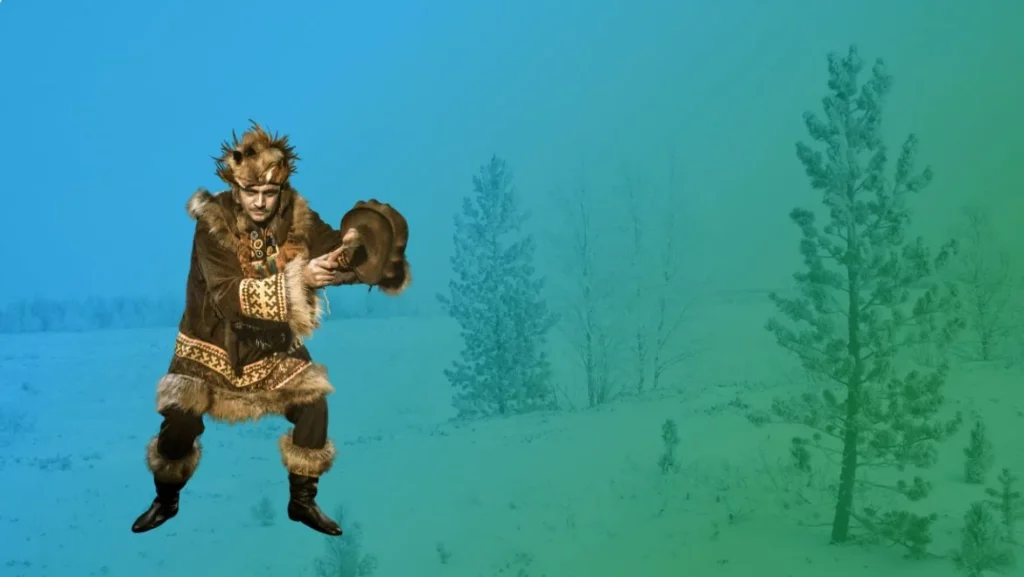
Origins and Significance in Siberian Culture
Siberian shamanism dates back thousands of years, with shamanic elements visible in the archaeological record of the region. It played a central role in the nomadic and semi-nomadic lifestyles of Siberian tribes, providing spiritual guidance, healing, and a means of negotiating the harsh and unpredictable environment. Shamans were revered figures, believed to possess the ability to travel to other worlds, communicate with spirits, and bring back knowledge and healing.
Shamanic Tools: Drums, Costumes, and Spirit Animals
- Drums: The shaman’s drum is a key tool in Siberian shamanism, serving as a vehicle for the shaman’s journey to the spirit world. The drum’s beat mimics the heartbeat, symbolizing the connection between all living things and facilitating the shaman’s altered state of consciousness.
- Costumes: Siberian shamans wear elaborate costumes often adorned with symbols and objects representing their spirit guides, power animals, and the realms they navigate. These costumes serve to protect the shaman, attract helpful spirits, and intimidate malevolent ones.
- Spirit Animals: Spirit animals play a crucial role in Siberian shamanism, acting as guides, protectors, and sources of strength. Shamans form close bonds with their spirit animals, which assist them in their spiritual journeys and tasks.

Ceremonies and Rituals: Healing, Divination, and Guiding Souls
Siberian shamans perform a variety of rituals aimed at healing physical and spiritual ailments, divining future events, and guiding the souls of the deceased to the afterlife. These ceremonies often involve complex rituals, including the use of the drum, chanting, and dancing to enter trance states.
- Healing: Shamans diagnose and treat illnesses caused by spiritual disturbances, using a combination of ritual, herbal medicine, and spiritual interventions to restore balance.
- Divination: Through various methods, including scrying, dream interpretation, and communication with spirits, shamans provide guidance and insights into future events, helping their communities make informed decisions.
- Guiding Souls: One of the key roles of the Siberian shaman is to assist the souls of the deceased in transitioning to the afterlife, ensuring they do not remain to haunt the living.
Core Shamanism
Core Shamanism is a contemporary form of shamanism that distills the universal aspects of shamanic practices from around the world, focusing on their shared techniques and principles rather than the cultural specifics of any single tradition. Developed by anthropologist Michael Harner in the late 20th century, Core Shamanism aims to make shamanic healing and practices accessible to people in modern societies, regardless of their cultural background.
Michael Harner’s Contributions and the Foundation of Core Shamanism
Michael Harner, after extensive fieldwork among indigenous tribes in the Amazon and other parts of the world, concluded that certain shamanic practices were nearly universal. He focused on these core practices, stripping away the cultural trappings to create a system that could be applied universally. Harner’s work, including his seminal book “The Way of the Shaman,” has been instrumental in popularizing shamanism in the West.
Techniques: Shamanic Journeying, Power Animals, and Extraction Healing
- Shamanic Journeying: At the heart of Core Shamanism is the practice of shamanic journeying, a meditative process that allows individuals to enter non-ordinary reality (a term Harner used to describe the spiritual realm) to seek guidance, wisdom, and healing. This is typically done with the aid of drumming or other rhythmic sounds to induce a trance-like state.
- Power Animals: Similar to spirit guides in other shamanic traditions, power animals are believed to be spirit helpers in animal form that provide protection, strength, and guidance to the practitioner. Finding and building a relationship with one’s power animal is a fundamental aspect of Core Shamanism.
- Extraction Healing: This technique involves the removal of spiritual intrusions or negative energies that are believed to cause illness or disharmony in a person. The shamanic practitioner, working in non-ordinary reality, locates and extracts these intrusions, restoring balance and well-being.
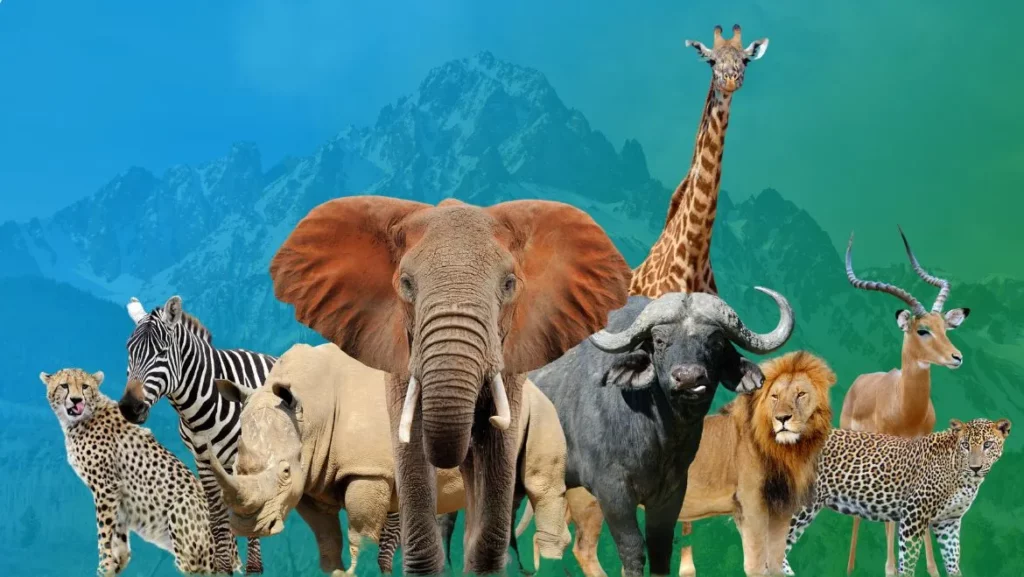
Application in Modern Healing Practices
Core Shamanism is often integrated with modern therapeutic practices to address physical, mental, and emotional health issues. Practitioners might use shamanic journeying to uncover the spiritual aspects of an illness or to facilitate deep emotional healing. The approach is holistic, considering the well-being of the entire person—body, mind, and spirit.
Harner’s Core Shamanism does not require adherence to any specific cultural traditions, making it accessible to individuals regardless of their heritage. It offers a framework for engaging with the ancient practice of shamanism in a way that is relevant to contemporary life, focusing on personal growth, healing, and the development of spiritual connection.
Through workshops, books, and training programs, Core Shamanism has grown in popularity, offering a spiritual practice that is both deeply rooted in ancient wisdom and adaptable to the needs of modern individuals seeking to reconnect with the spiritual dimensions of existence.
Celtic Shamanism
Celtic shamanism draws from the spiritual traditions and practices of the ancient Celts, a diverse group of tribes with a rich culture that once spread across much of Europe. This path combines elements of shamanism with the myths, folklore, and magical practices of the Celtic peoples, emphasizing a deep connection to the Earth, its cycles, and the otherworldly realms of Celtic lore.

Historical Roots in Druidic Traditions
The Druids, the priestly class in ancient Celtic societies, are often associated with the shamanic aspects of Celtic spirituality. They were known for their roles as healers, seers, and keepers of wisdom, with an intimate understanding of the natural world and its forces. Although much of the original Druidic knowledge was lost due to the lack of written records and the impact of Roman and Christian conquests, remnants of their practices have been preserved in myths, legends, and the traditions of the Celtic nations.
Practices: Ogham Divination, Tree Lore, and Journeying to the Otherworld
- Ogham Divination: The Ogham is an ancient Celtic alphabet, each character associated with a specific tree or plant. It is used in Celtic shamanism for divination and communication with the spirit world, with each tree embodying unique spiritual qualities and wisdom.
- Tree Lore: Trees hold a sacred place in Celtic shamanism, seen as powerful beings that bridge the Earth and the heavens. Practices involve working with tree spirits for healing, guidance, and accessing the otherworldly realms.
- Journeying to the Otherworld: Similar to shamanic journeying in other traditions, Celtic shamanism involves journeys to the Otherworld, a realm of gods, ancestors, and spirits. These journeys, guided by drumming, visualization, and ritual, offer insight, healing, and spiritual communion.

Celebrations of the Wheel of the Year and Their Shamanic Significance
The Celtic Wheel of the Year, with its eight festivals, marks the seasonal cycles and the life-giving rhythms of nature. These festivals, including Samhain, Imbolc, Beltane, and Lughnasadh, are times of deep spiritual significance in Celtic shamanism. Each festival offers opportunities for rituals, connecting with the spirits of the land, and aligning with the transformative energies of the Earth’s cycles.
Mongolian and Tuvan Shamanism
Mongolian and Tuvan shamanism are vibrant expressions of the shamanic traditions that have been practiced across the steppes and mountains of Central Asia for millennia. These traditions, deeply interwoven with the nomadic lifestyles and the stark landscapes of the region, emphasize the connection between humans, the natural world, and the spirit realm.

Cultural Background and Shamanic Heritage
In Mongolia and Tuva, shamanism is an integral part of cultural identity, with a history that predates the introduction of Buddhism and other religions to the region. The harsh and expansive landscapes of Central Asia have shaped a worldview where nature is revered and spirits are seen in every mountain, river, and wind. Shamans, known as “böö” in Mongolia and “kam” in Tuva, are respected as healers, mediators, and spiritual leaders.
Distinctive Features: Costume, Throat Singing, and Shamanic Drumming
- Costume: Mongolian and Tuvan shamans wear elaborate costumes during rituals, often adorned with symbols and objects that represent their spiritual power and connections. These costumes can include mirrors, metal jingles, and feathers, which are believed to protect the shaman and reflect negative energies.
- Throat Singing: Particularly in Tuva, throat singing is a unique musical expression that’s closely associated with shamanic practices. This form of overtone singing is used to mimic and communicate with the natural sounds of the landscape, creating a bridge between the human and spiritual worlds.
- Shamanic Drumming: Drums play a crucial role in Mongolian and Tuvan shamanic rituals, used to induce trance states and facilitate the shaman’s journey to the spirit world. The drum is often considered the shaman’s horse, carrying them across the boundaries of the physical and spiritual realms.

The Role of Shamans in Society and Modern Resurgence
In Mongolian and Tuvan societies, shamans are sought after for their abilities to heal sickness, divine the future, and communicate with the ancestors and spirits of nature. They perform rituals to ensure the well-being of their communities, protect livestock, and maintain the balance between humans and the natural world.
Despite periods of suppression, particularly during Soviet rule, shamanism has experienced a revival in recent years. This resurgence is driven by a renewed interest in indigenous spirituality, national identity, and ecological concerns. Today, shamans continue to play a vital role in Mongolian and Tuvan communities, bridging the ancient and the modern with their timeless wisdom and practices.
Korean Shamanism (Muism)
Korean Shamanism, also known as Muism, is a complex and multifaceted spiritual tradition deeply ingrained in the cultural fabric of Korea. It encompasses a wide range of practices and beliefs centered around the worship of gods, ancestors, and nature spirits. Muism is characterized by its vibrant rituals, colorful ceremonies, and the central role of shamans, known as “mudang,” who mediate between the human and spiritual realms.
Overview of Korean Shamanic Beliefs and Practices
Muism is based on the belief that all things in the universe possess a spiritual essence and that harmony between these spirits, humans, and nature is essential for well-being and prosperity. The mudang, often women, are considered to possess powerful abilities to communicate with the spiritual world, gained either through hereditary lines or through a calling marked by significant spiritual and physical trials, known as “shinbyeong.”
Kut Ceremonies: Structure, Music, Dance, and Spirit Possession
- Kut Ceremonies: These are elaborate rituals performed by mudang to appease and communicate with the spirits, seeking their guidance, blessings, and healing for individuals or communities. The kut can vary greatly in scale and purpose, ranging from small, private rituals to large, public ceremonies.
- Music and Dance: Music, drumming, and dance are integral to kut ceremonies, used to invoke spirits, facilitate trance states, and express the narratives of gods and ancestors. The vibrant and dynamic performances are both a form of worship and a medium for storytelling.
- Spirit Possession: A distinctive aspect of kut ceremonies is the phenomenon of spirit possession, where the mudang embodies various deities or ancestral spirits, speaking and acting as them to convey messages, blessings, or admonitions to the participants.

The Mudang’s Role in Healing and Community Rituals
Mudang are sought after for their abilities to provide solutions to personal and communal problems, ranging from health issues and personal dilemmas to conflicts within the community. Through divination, offerings, and communication with the spirits, they diagnose spiritual disturbances and prescribe remedies, often involving additional rituals, offerings, or lifestyle changes.
Despite facing periods of suppression and stigma, especially during the rapid modernization of Korea in the 20th century, Korean Shamanism has experienced a resurgence of interest and recognition as an essential part of Korea’s cultural heritage. Today, kut ceremonies are not only sought for spiritual and practical solutions but also celebrated as expressions of Korean identity and tradition.
African Shamanism
African shamanism encompasses a vast and diverse array of spiritual traditions found throughout the African continent. These traditions are deeply rooted in the rich tapestry of African cultures, languages, and histories, with each community having its own unique practices, deities, and spiritual beliefs. Central to African shamanism is the role of the shaman or traditional healer, known by various titles such as “sangoma” in Southern Africa or “dibia” in West Africa, who serves as a mediator between the physical and spiritual worlds.
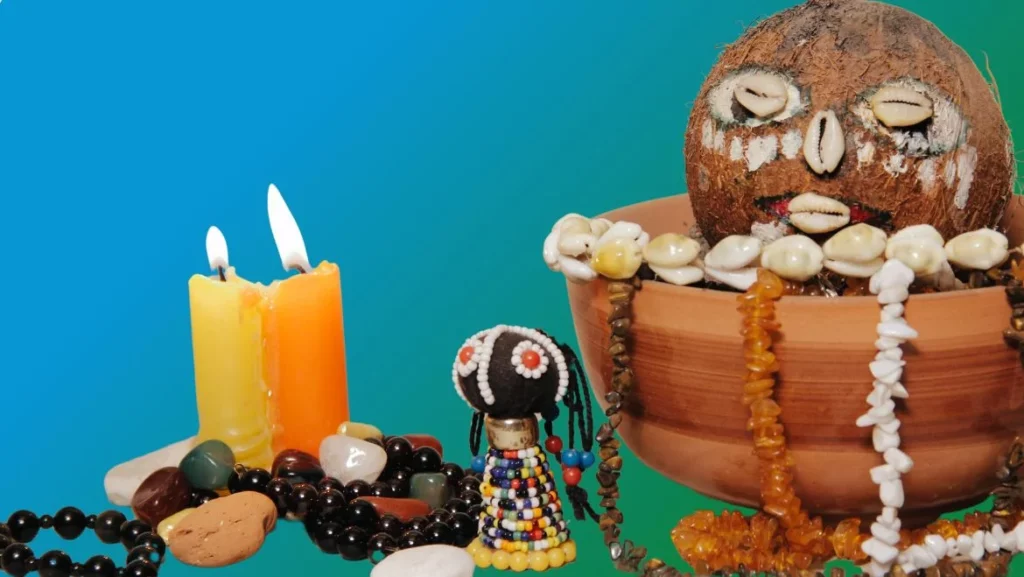
Diversity of Shamanic Traditions Across Africa
The diversity in African shamanic practices reflects the continent’s wide-ranging cultures and ecosystems, from the deserts of North Africa to the rainforests of the Congo Basin and the savannahs of the Serengeti. Despite this diversity, common themes include a profound connection with the ancestors, the use of divination to communicate with the spirit world, and the belief in the interconnectedness of all living things.
Common Elements: Ancestor Worship, Spirit Possession, and Tribal Rituals
- Ancestor Worship: Reverence for ancestors is a cornerstone of many African shamanic traditions. Ancestors are seen as guardians and guides, and maintaining a positive relationship with them through rituals and offerings is considered essential for individual and community well-being.
- Spirit Possession: Similar to other shamanic traditions, spirit possession is a significant aspect of African shamanic rituals, where the shaman or another participant becomes a vessel for a deity or ancestor. This state is often used for healing, divination, or conveying messages from the spirit world.
- Tribal Rituals: Community rituals and ceremonies play a vital role in African shamanism, marking important life transitions, seasonal changes, and significant events. These rituals often involve music, dance, and the use of traditional medicines and are designed to ensure harmony between the community, the natural world, and the spiritual realm.
Sangomas and Traditional Healers in Southern Africa
In Southern Africa, traditional healers known as “sangomas” are highly respected figures who diagnose and treat not only physical ailments but also spiritual and social issues. Their training, which involves rigorous initiation processes and apprenticeships, equips them with knowledge of herbal medicine, bone divination, and the ability to communicate with ancestors.
Despite challenges posed by modernization and the spread of other religious practices, African shamanism remains a vital part of the continent’s cultural heritage. It continues to adapt and evolve, addressing contemporary issues while remaining rooted in ancient wisdom and practices. African shamanic traditions, with their deep connection to the earth, community, and the ancestors, offer powerful insights into the ways in which spirituality can inform and enrich daily life, fostering a sense of unity and balance within the broader tapestry of life.
Native American Shamanism
Native American shamanism encompasses a wide range of practices and beliefs held by the indigenous peoples of North America. Each tribe and culture has its unique traditions, but common to many is the role of the shaman or medicine person as a healer, guide, and intermediary between the physical world and the spiritual realm.

Variety of Practices Among Different Tribes
The diversity of Native American cultures, each with its own language, history, and spiritual practices, has given rise to a rich mosaic of shamanic traditions. From the Navajo in the Southwest with their elaborate sand painting and healing ceremonies to the Iroquois in the Northeast with their longhouse rituals, each group has developed practices that reflect their relationship with the land, community, and the cosmos.
Medicine Men/Women: Healing Practices, Vision Quests, and Sacred Ceremonies
- Healing Practices: Native American shamans, often called medicine men or women, use a variety of methods to heal, including herbal remedies, purification rituals like sweat lodges, and the channeling of spiritual energy. They diagnose not only physical ailments but also spiritual and psychological imbalances.
- Vision Quests: Vision quests are a form of spiritual journey undertaken, typically alone, in the wilderness to seek guidance or insights from the spirit world. This rite of passage, involving fasting and prayer, is crucial for personal growth and understanding one’s purpose and place within the community and the natural world.
- Sacred Ceremonies: Ceremonies are central to Native American shamanism, serving to connect the community, honor the spirits, and mark significant life events or seasonal changes. The Sun Dance, among the Plains Indians, and potlatch ceremonies in the Pacific Northwest are examples of such communal rituals.
The Significance of Nature and Animal Spirits
A foundational aspect of Native American shamanism is the deep reverence for nature and the belief that everything in the natural world has a spirit. Shamans work closely with animal spirits, or totems, which provide guidance, protection, and power to the individual and the community. The harmonious relationship with the earth and all its creatures is a guiding principle, reflecting an ecological awareness that is both ancient and profoundly relevant today.
Despite the challenges and changes brought by European colonization, Native American shamanic traditions have shown resilience and adaptability. In recent years, there has been a resurgence of interest in these practices, both within Native American communities seeking to preserve their heritage and among others drawn to the wisdom and spirituality of these ancient paths.
Andean Shamanism
Andean shamanism is deeply rooted in the rich cultural tapestry and dramatic landscapes of the Andes Mountains, spanning countries like Peru, Bolivia, Ecuador, and parts of Chile and Argentina. This tradition, with its ancient origins predating the Inca civilization, is a vibrant synthesis of pre-Columbian beliefs and later influences, including Catholicism. Central to Andean shamanism are the concepts of living in harmony with nature, the community, and the cosmos, embodied in the Quechua term “Ayni,” meaning reciprocity or mutual exchange.
Andean Cosmology and Reverence for Pachamama and Apus
Andean cosmology is characterized by its reverence for Pachamama (Mother Earth) and the Apus (mountain spirits), viewing them as living beings that offer protection and sustenance. This worldview fosters a deep respect for the natural world, emphasizing the interconnectedness of all life and the importance of maintaining balance and harmony.
Paqos and Curanderos: Coca Leaf Divination and Despacho Offerings
- Paqos and Curanderos: In Andean shamanism, the practitioners, known as “paqos” in Quechua and “curanderos” in Spanish, serve as intermediaries between the physical and spiritual worlds. They are healers, seers, and ritual specialists who work to maintain the balance between humans, nature, and the spirit world.
- Coca Leaf Divination: The coca leaf, sacred in Andean culture, is used by paqos for divination and communication with the spiritual realm. By reading the arrangement of coca leaves, paqos gain insights into the present and future, offering guidance and solutions to those who seek their help.
- Despacho Offerings: Despachos are elaborate ritual offerings made to Pachamama, the Apus, and other spirits, consisting of various symbolic items like coca leaves, grains, sweets, and figurines wrapped in a cloth. These offerings are made to express gratitude, seek blessings, and ensure harmony and well-being.
Integration with Catholicism and Contemporary Practices
Andean shamanism has absorbed elements of Catholicism, creating a syncretic blend where Christian saints coexist with indigenous deities and spirits. This integration is evident in rituals and festivals, where Catholic icons are revered alongside Pachamama and the Apus. Despite the challenges of modernization and cultural change, Andean shamanism remains a vital part of the region’s spiritual landscape, adapting to contemporary life while preserving ancient wisdom.
The rich traditions of Andean shamanism, with their emphasis on living in harmony with the Earth and the broader cosmos, offer profound insights into sustainable and reciprocal ways of being. These practices remind us of the importance of gratitude, respect, and balance in our interactions with the natural world and each other, providing a pathway to healing and spiritual connection in the modern world.
Shamanic Tools and Symbols
Shamanic traditions across the globe, despite their diverse cultural backgrounds, share a common language in the use of tools and symbols. These objects are not merely physical items but are imbued with spiritual significance, acting as conduits for healing, protection, and communication with the spirit world. Understanding the role and meaning of these tools and symbols provides insight into the universal aspects of shamanic practice.
Common Tools Across Various Traditions
- Drums and Rattles: Perhaps the most universal shamanic tool, the drum is used in numerous cultures to induce trance states and facilitate journeying to the spirit world. The repetitive rhythm mimics the heartbeat, connecting the shaman to the web of life. Rattles, similarly, are used to clear energies, call in spirits, and enhance the shaman’s connection to other realms.
- Ceremonial Attire: Shamanic practitioners often wear special garments during rituals, believed to hold protective powers and to symbolize their connection to the spirit world. These may include robes, headdresses, masks, and jewelry, often adorned with symbols of their spirit allies and power animals.
- Staffs and Wands: Used in many traditions to direct energy, invoke spirits, and delineate sacred space, staffs and wands are powerful tools for shamans. They are often crafted from materials with particular spiritual significance, such as wood from sacred trees or bones from totem animals.
Symbols and Their Meanings
- World Tree: The World Tree is a pervasive symbol in shamanic cosmologies, representing the connection between the underworld, the earthly realm, and the heavens. It embodies the shaman’s ability to traverse these worlds, serving as a map and a pathway for spiritual journeys.
- Spirit Animals: Many shamanic cultures believe in spirit animals or power animals that guide, protect, and empower the shaman and those they heal. These animals symbolize the traits and strengths that the practitioner can draw upon, reflecting the deep connection between humans and the natural world.
- Sacred Geometries: Symbols such as the spiral, circle, and mandala are common in shamanic art and rituals, representing concepts like the cycle of life, the interconnectedness of all beings, and the journey of spiritual awakening.
The Role of Tools and Symbols in Shamanic Practice
In shamanism, tools and symbols are not only aids for ritual and healing but also serve as bridges between the material and spiritual worlds. They facilitate communication with spirits, enhance the practitioner’s power, and protect against negative energies. Their use and significance are often revealed through personal spiritual experiences, dreams, or guidance from spirit guides and teachers.
Shamanic tools and symbols, with their rich meanings and uses, highlight the deep relationship between the practitioner, the natural world, and the spirit realm. They remind us of the power of intention, the importance of respect for all life, and the potential for transformation inherent in the shamanic journey.

The Role of Shamans in Contemporary Society
The role of shamans, those who navigate the realms of spirit and matter to bring healing and balance, has evolved significantly in contemporary society. While maintaining the essence of their ancient traditions, shamans today navigate a world vastly different from that of their ancestors, adapting their practices to modern needs and challenges. This adaptation highlights the enduring relevance of shamanism and its potential to address the spiritual and ecological crises of the modern world.
Challenges and Adaptations of Shamanic Practices in the Modern World
Shamans today face the challenge of preserving their traditional practices in a world that often prioritizes scientific rationalism and material success. Despite this, there is a growing recognition of the value of holistic and spiritual approaches to healing and well-being. Shamans adapt by integrating their practices with contemporary life, using modern communication tools to share their wisdom and reach those in need, and often combining shamanic practices with modern therapeutic techniques to address a wide range of issues.
Shamanism and Psychology: Healing Trauma and Spiritual Growth
One of the most significant contributions of shamanism to contemporary society is its holistic approach to healing, which addresses the physical, emotional, mental, and spiritual dimensions of the individual. This approach is particularly effective in healing trauma, as shamanic practices offer deep, transformative experiences that can release and heal deep-seated wounds. The integration of shamanic techniques with psychology and trauma therapy opens new pathways for healing and personal growth.
The Resurgence of Interest in Shamanic Practices and Their Global Relevance
There is a resurgence of interest in shamanic practices, driven by a global search for meaning, connection, and healing in an increasingly fragmented world. People from diverse backgrounds are drawn to shamanism for its direct, experiential approach to spirituality, its reverence for nature, and its powerful healing practices. This growing interest speaks to the universal human need for spiritual connection and the recognition of the interdependence of all life.

Shamans in contemporary society act as bridges between ancient wisdom and modern life, offering pathways to healing, self-discovery, and a deeper relationship with the natural world. Their role is not only to heal and guide individuals but also to remind us of the sacredness of life and the importance of living in harmony with each other and the Earth. As we face ecological crises and a global search for meaning, the wisdom of shamanism offers valuable insights into creating a more balanced, sustainable, and spiritually fulfilled society.
Conclusion
In exploring the rich tapestry of shamanic traditions from around the globe, we uncover a profound connection to the spiritual dimensions of existence that transcends cultural and geographic boundaries. Shamanism, in its myriad forms—from the rainforests of the Amazon to the steppes of Mongolia, from the Andean highlands to the deserts of Africa—offers a window into the universal human quest for healing, understanding, and a harmonious relationship with the natural world.
The core principles of shamanism, such as the interconnectedness of all life, the reverence for nature, and the journeying to other realms for wisdom and healing, resonate deeply with the challenges and aspirations of contemporary society. As we grapple with environmental degradation, social fragmentation, and a hunger for authentic spiritual experience, the ancient practices of shamans provide not only a balm for the soul but also practical guidance for living in balance with the Earth and each other.
The resurgence of interest in shamanic practices reflects a broader awakening to the limitations of materialistic worldviews and a desire to reconnect with the spiritual and ecological wisdom of our ancestors. By integrating the insights and practices of shamanism with the advances of modern science and psychology, we can forge pathways to a more sustainable, compassionate, and spiritually fulfilling way of life.




